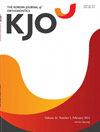前牙后缩时,哪一种支抗装置效果最好?系统综述
IF 1.9
3区 医学
Q1 Dentistry
引用次数: 2
摘要
目的评价不同类型固支器的临床疗效。方法全面检索截至2021年4月15日发表的不同锚固方法的电子数据库,进行系统综述。使用PROSPERO检索所有正在进行的系统评价,并使用Google Scholar和OpenGrey进行灰色文献检索。没有使用语言限制。筛选、质量评估和数据提取由两位作者独立完成。对信息进行分类,并对来自中等和高质量综述的主要发现进行叙述性综合。结果共纳入14篇系统评价,其中11篇为中、高质量评价。使用微型支架的骨骼锚固与较少的锚固损失相关(有时与锚固增加有关)。同样,骨支抗在前牙内缩、门牙和磨牙内缩时更有效,导致轻微的垂直骨骼变化和软组织剖面的改善。然而,在治疗时间、预约次数、治疗质量、患者感知或不良反应方面,没有足够的证据证明任何锚定方法的首选。当直接加载,用于下颌骨而不是上颌骨,使用颊部而不是腭部,使用双微型螺钉而不是单微型螺钉,用于大规模内缩和成人时,骨骼锚固的有效性可以得到提高。结论关于支具有效性的证据水平是中等的。然而,与传统锚固相比,骨骼锚固可以使用更多的锚固保存。需要进一步的高质量随机临床试验来证实这些发现。本文章由计算机程序翻译,如有差异,请以英文原文为准。
Which anchorage device is the best during retraction of anterior teeth? An overview of systematic reviews
Objective To evaluate the available evidence regarding the clinical effectiveness of different types of anchorage devices. Methods A comprehensive literature search of different electronic databases was conducted for systematic reviews investigating different anchorage methods published up to April 15, 2021. Any ongoing systematic reviews were searched using PROSPERO, and a grey literature search was undertaken using Google Scholar and OpenGrey. No language restriction was applied. Screening, quality assessment, and data extraction were performed independently by two authors. Information was categorized and narratively synthesized for the key findings from moderate- and high-quality reviews. Results Fourteen systematic reviews were included (11 were of moderate/high quality). Skeletal anchorage with miniscrews was associated with less anchorage loss (and sometimes with anchorage gain). Similarly, skeletal anchorage was more effective in retracting anterior teeth and intruding incisors and molars, resulting in minor vertical skeletal changes and improvements in the soft tissue profile. However, insufficient evidence was obtained for the preference of any anchorage method in terms of the duration of treatment, number of appointments, quality of treatment, patient perception, or adverse effects. The effectiveness of skeletal anchorage can be enhanced when directly loaded, used in the mandible rather than the maxilla, used buccally rather than palatally, using dual rather than single miniscrews, used for en-masse retraction, and in adults. Conclusions The level of evidence regarding anchorage effectiveness is moderate. Nevertheless, compared to conventional anchorage, skeletal anchorage can be used with more anchorage preservation. Further high-quality randomized clinical trials are required to confirm these findings.
求助全文
通过发布文献求助,成功后即可免费获取论文全文。
去求助
来源期刊

Korean Journal of Orthodontics
Dentistry-Orthodontics
CiteScore
2.60
自引率
10.50%
发文量
48
审稿时长
3 months
期刊介绍:
The Korean Journal of Orthodontics (KJO) is an international, open access, peer reviewed journal published in January, March, May, July, September, and November each year. It was first launched in 1970 and, as the official scientific publication of Korean Association of Orthodontists, KJO aims to publish high quality clinical and scientific original research papers in all areas related to orthodontics and dentofacial orthopedics. Specifically, its interest focuses on evidence-based investigations of contemporary diagnostic procedures and treatment techniques, expanding to significant clinical reports of diverse treatment approaches.
The scope of KJO covers all areas of orthodontics and dentofacial orthopedics including successful diagnostic procedures and treatment planning, growth and development of the face and its clinical implications, appliance designs, biomechanics, TMJ disorders and adult treatment. Specifically, its latest interest focuses on skeletal anchorage devices, orthodontic appliance and biomaterials, 3 dimensional imaging techniques utilized for dentofacial diagnosis and treatment planning, and orthognathic surgery to correct skeletal disharmony in association of orthodontic treatment.
 求助内容:
求助内容: 应助结果提醒方式:
应助结果提醒方式:


